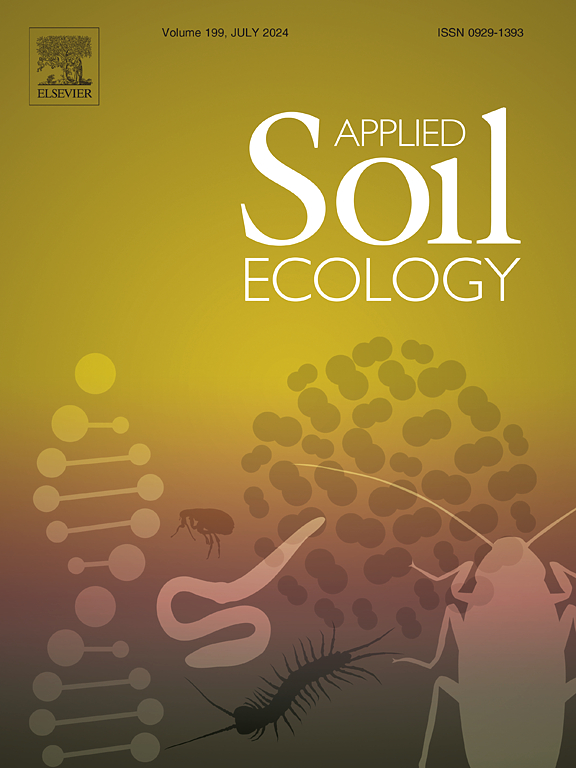不同历史降水量草原土壤酶动力学对降水变化的差异性响应
IF 5
2区 农林科学
Q1 SOIL SCIENCE
引用次数: 0
摘要
土壤胞外酶催化是土壤有机质分解的限速步骤,Vmax和Km是反映酶催化能力的酶动力学参数。然而,目前尚不清楚这些酶的动力学参数如何响应降水变化并随后影响土壤微生物呼吸(Rh)。本文研究了荒漠草原、典型草原和草甸草原在降水变化(- 30%、环境和+ 30%)下7种土壤水解酶和多酚氧化酶(PPO)、Rh和微生物生物量碳(MBC)的Vmax和Km。结果表明:草甸的水解酶Vmax和PPO均高于荒漠和典型草原;干旱降低了荒漠和典型草原中C-、N-、p -降解酶和PPO的Vmax,但在草甸草原中没有观察到这些变化,说明干旱生态系统中Vmax对降水变化的敏感性更大。同样,降水变化对Rh和MBC也有相同的影响。然而,降水变化对Km的影响因酶和生态系统类型的不同而不同。酶Vmax的变化与土壤湿度和地下净初级产量的变化呈正相关。此外,β-葡萄糖苷酶(BG)的Vmax和Km以及亮氨酸氨基肽酶的Vmax是Rh变异的最佳预测因子。偏最小二乘路径模型进一步揭示了Rh对降水变化的响应受亮氨酸氨基肽酶BG和Vmax动力学参数的直接调节,而不受MBC的影响。这些发现为土壤水解酶动力学与Rh之间的联系提供了重要的见解,促进了我们对气候变化下土壤有机质分解机制的理解。本文章由计算机程序翻译,如有差异,请以英文原文为准。
Divergent responses of soil enzyme kinetics to altered precipitation across steppes with varying historical precipitation
Soil extracellular enzymatic catalysis is the rate-limiting step in soil organic matter decomposition, and Vmax and Km are enzyme kinetic parameters reflecting enzyme catalytic capacity. However, it is still far from clear how these enzyme kinetic parameters respond to altered precipitation and subsequently influence soil microbial respiration (Rh). Here, we examined the Vmax and Km of seven soil hydrolytic enzymes and polyphenol oxidase (PPO), Rh, and microbial biomass carbon (MBC) under altered precipitation (− 30%, ambient, and + 30%) across Desert, Typical, and Meadow steppes. The results showed that the Vmax of hydrolytic enzymes and PPO were higher in the meadow than desert and typical steppes. Drought decreased the Vmax of C-, N-, P-degrading enzymes and PPO in the desert and typical steppes, but these changes were not observed in the meadow steppe, indicating the greater sensitivity of Vmax to altered precipitation in drier ecosystems. Similarly, there were the same patterns of Rh and MBC induced by changes in precipitation. However, changes in precipitation differently affected Km depending on enzymes and ecosystem types. Changes in Vmax of enzymes positively correlated with changes in soil moisture and belowground net primary production. Moreover, the Vmax and Km of β-glucosidase (BG) and the Vmax of leucine aminopeptidase were the best predictors for variability in Rh. Partial least squares path modeling further revealed that Rh response to altered precipitation was directly regulated by kinetic parameters of BG and Vmax of leucine aminopeptidase, rather than by MBC. These findings provide important insights into the linkages between soil hydrolase kinetics and Rh, advancing our understanding of the mechanisms of soil organic matter decomposition under climatic change.
求助全文
通过发布文献求助,成功后即可免费获取论文全文。
去求助
来源期刊

Applied Soil Ecology
农林科学-土壤科学
CiteScore
9.70
自引率
4.20%
发文量
363
审稿时长
5.3 months
期刊介绍:
Applied Soil Ecology addresses the role of soil organisms and their interactions in relation to: sustainability and productivity, nutrient cycling and other soil processes, the maintenance of soil functions, the impact of human activities on soil ecosystems and bio(techno)logical control of soil-inhabiting pests, diseases and weeds.
 求助内容:
求助内容: 应助结果提醒方式:
应助结果提醒方式:


